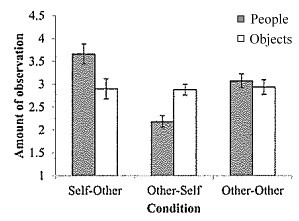Sunday, September 17, 2017
Invisibility Cloak Illusion Hypothesis

Recent research (Boothby, Clark, & Bargh, 2017) has found that Americans believe that everyone looks at objects about equally but that they observe others more than others do, and about twice as much as others observe themselves, even though this is not the case.
The authors termed this bias the "invisibility cloak illusion" since the data implies that we feel ourselves to be invisible, or indeed that we are invisible to ourselves as hinted at by some researchers (Smith, 1827; Rochat, 2009). This result is unlikely to be universal. Research by myself and colleagues (Heine, et al., 2008) has shown that Japanese are chronically visible to themselves at least in terms of simulated mirror images.
In other research we (Takemoto, & Imamura, 2001) have shown that schizophrenics are better at judging the size of their extremities than those without schizophrenia, judging hand sizes almost exactly at a typical 30cm viewing distance, and at 2 metres, whereas non schizophrenics judge hands to be 10-15% smaller than they are. This suggests that the bodies of schizophrenics at least are not invisible to themselves as also suggested by some schizophrenics (Pans Disease, 2017).
The misjudgement of hand sizes, but not bank notes, was found among Japanese participants who judged their hands to be up to about 15% smaller than in reality, possibly due to the fact that they identify with their mirror images, which they often do not see as being left-right reversed (Takano & Tanaka, 2007).
I predict that the invisibility cloak illusion (Boothby, Clark, & Bargh, 2017) will be absent among Japanese. Indeed the Japanese may feel that they are observed by others more than they observe others themselves. Further I feel that the researchers would profitably have asked two more types of question, "how often do you/others (simulate) observing yourself/themselves?" which would show a greater cultural difference being the lowest type of observation in the West, but perhaps having the highest reported/estimated incidence in Japan.
Image reproduced without permission from Boothby, Clark, and Bargh (2017, p. 9). Should you wish that I cease an desist please drop me a note in the comments or by mail to the email link at nihonbunka.com.
Boothby, E. J., Clark, M. S., & Bargh, J. A. (2017). The invisibility cloak illusion: People (incorrectly) believe they observe others more than others observe them. Journal of personality and social psychology, 112(4), 589.
Heine, S. J., Takemoto, T., Moskalenko, S., Lasaleta, J., & Henrich, J. (2008). Mirrors in the head: Cultural variation in objective self-awareness. Personality and Social Psychology Bulletin, 34(7), 879-887.
Rochat, P. (2009). Others in mind: Social origins of self-consciousness. Cambridge University Press.
Takano, Y., & Tanaka, A. (2007). Mirror reversal: Empirical tests of competing accounts. The Quarterly Journal of Experimental Psychology, 60(11), 1555-1584.
Takemoto, T., Imamura, G. 武本Timothy and 今村義臣(2001)"分裂病患者の身体像:身体の末梢部位と物体の 大きさの恒常性" 九州社会心理学会, 佐賀大学
Labels: Nacalian, nihonbunka, philosophy, 日本文化
This blog represents the opinions of the author, Timothy Takemoto, and not the opinions of his employer.
